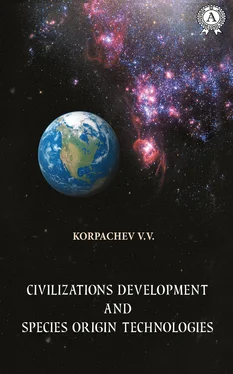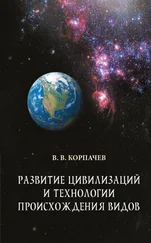M. Sherman, a professor of Boston University, put forward the hypothesis of the «universal genome’s» artificial occurrence in Cambria to explain the causes of the so-called Cambrian explosion in the evolution of multicellular organisms. Moreover, he insists on the possibility of his hypothesis’s scientific verification.
In favour of their views, supporters of the panspermia hypothesis provide two indirect evidences in favour of their views: the genetic code universality and the need of molybdenum availability for the normal metabolism for all living creatures, which is currently extremely rare on the planet. Supporters of the comet panspermia theory deny the life spreading from one planet to other one process’s controllability, and suggest its spontaneity and chance.
Taking into consideration the fact that the life spontaneous occurrence’s probability on Earth is extremely negligible, the panspermia hypothesis is the most real in comparison with both the evolutionary theory and religious beliefs. Its disadvantage is that it does not explain how and where the first microorganisms to come to Earth were formed; it only indicates the other place where it could have occurred, but does not explain the process and the reasons for the given occurrence.
1.3. THE EVOLUTIONARY THEORY
The evolution theory is highly ranked in the study of the history of the origin of life on Earth. Jean-Baptiste Lamarck was the first to identify two most common trends of the life on Earth’s development: the upward development from simplest forms to more complex and advanced ones and the adaptations’ formation in organisms depending on environmental conditions (vertical and horizontal development). In his works, the scientist noted the organisms’ historical development, which is not of random but of regular nature and occurs in the direction of gradual and steady improvement. He believed that the organisms’ development is not a spontaneous process. In his opinion, «the nature’s drive for progress», «the drive for perfection» was originally inherent in all organisms and laid down in them by the Creator. He argued in his paper «Philosophy of Zoology» that subsequent generations are able to inherit acquired useful properties thus forming new species. For example, in his opinion, giraffes generated from antelopes due to the constant extension of their necks when they tried to reach the leaves on the tops of trees.
Ch. Darwin, being inspired by similar examples, continued the Lamarckian series of assumptions. In his book «The Origin of Species through Natural Selection,» he revealed the main organic world’s evolution factors. Approximately at the same time, Alfred Russel Wallace published an article entitled «On the Law Which Has Regulated the Introduction of New Species», in which he came up with the idea of «survival of the most adapted ones».
Ch. Darwin grounded the theory of the gradual evolution of some species into other ones under the influence of such factors as the survival of the most adapted, the struggle for existence, natural selection, and adaptability to environmental conditions.
The essence of evolutionary doctrine lies in the following main points:
1. All the living creatures’ types that inhabit Earth have never been created by anyone.
2. Having occurred in a natural way, organic forms slowly and gradually transformed and improved in accordance with the surrounding conditions.
3. The species’ transformation in nature is based on such organisms’ properties as heredity and variability, as well as natural selection constantly occurring in nature.
4. Natural selection is carried out through a complex interaction of organisms with each other and with factors of inanimate nature; Ch. Darwin called this relationship a struggle for existence.
5. The adaptability of organisms to their living conditions and the diversity of species in nature is the result of evolution.
According to the mentioned above provisions, a variety of species possessing new specific features allowing a better adaptation to the environment (habitat) can be formed within each species. If the newly acquired qualities are inherited, then genetic differences are amplified in subsequent generations due to the selection of properties that ensure the genotypes’ survival and the new mutation’s accumulation. The mentioned above variety of species adapts better to existing conditions, phenotypically moving away from the parent species. Intraspecific competition leads to the deliberate (selective) removal of the least adapted to the environment individuals and an increase in the number of individuals whose properties favour the survival and reproduction in this habitat. According to the evolutionary theory proponents, such a natural selection is the main mechanism for the new species’ occurrence. Evolution is a process of long-term and gradual qualitative changes that ultimately result in the new species’ occurrence.
According to some evolutionary theory’s advocates, the palaeontological, biogeographic, systematics, plant and animal breeding, morphological, comparative embryology and comparative biochemistry data confirm the evolutionary occurrence of species through natural selection, although they are not indisputable evidence. Three groups of facts are used to confirm the theory. The first group represents examples of species’ minor changes observed within a geologically short period of time in the wild nature, as well as the results of agricultural plants and domestic animals’ breeding. The second group is the fossil record, which indicates a significant variability of life throughout the history of Earth. The third group of evidences deals with the similarity of the morphological features of the all organisms’ structure, which may indicate their common origin. All explanations of the facts discovered are reduced to a spontaneous random process without any intellectual interference in the programming system.
Charles Darwin formulated his theory of evolution in accordance with the morphological and physiological characteristics, using the natural selection ideas, but did not determine the source of variability in the population. A synthetic theory of evolution combining the Darwinian natural selection’s idea with the laws of heredity and population genetics was developed in the middle of the last century. Currently, it is the most developed system of ideas regarding the speciation’s processes. The hypothesis of the new genes’ recessivity was the impetus for its development; according to it mutations constantly arise in each reproducing group of organisms during the gamete maturation as a result of errors in the DNA replication. Therefore, the mutation process is the most important evolutionary factor, and the bulk of evolutionary material is represented by various forms of mutations, which are manifested by means of changes in the hereditary properties of organisms that occur naturally or are caused by artificial means. After the different types of isolation’s occurrence between populations, they begin to evolve independently, and as a result, genetic differences are gradually accumulated between them, and with time genetic incompatibility is achieved, and crossing becomes impossible.
Julian Huxley, the English biologist and naturalist, indicates in his famous book «Evolution: The Modern Synthesis» (1942) that the species is a system of populations that are reproductively isolated from other species’ populations, and each species is ecologically isolated; speciation lies in the genetic isolating mechanisms’ occurrence and is carried out mainly in conditions of geographical isolation. According to the J. Huxley’s ideas, reproductive isolation is the main criterion that indicates the speciation’s completion.
According to the synthetic theory of evolution, the formation of new species occurs as a result of the separation of individuals of one species into groups that do not interbreed, and the very evolution is defined as the populations’ genetic structure change over time. The allele’s frequency changes thus becoming more or less common compared to other forms of this gene. The acting evolution forces lead to changes in the allele frequency in this or that direction. The change disappears when the new allele reaches the fixation point − it completely replaces the ancestral allele or disappears from the population. Mutations increase the population’s variability due to the emergence of new genes’ allelic variants − mutational variability. If any allele increases the organism’s adaptability more than other ones of the given gene, then the share of this allele in the population will increase with each generation, i.e., selection takes place in favour of this allele. Evolution through the natural selection is a process in which mutations increasing the organisms’ adaptability are fixed. As a result, three processes are necessary for the evolution’s implementation: mutational (to generate new variants of genes with a low phenotypic expression); recombination (to create new phenotypes of individuals), and selection (to determine the compliance of these phenotypes with the given living conditions or growth).
Читать дальше












